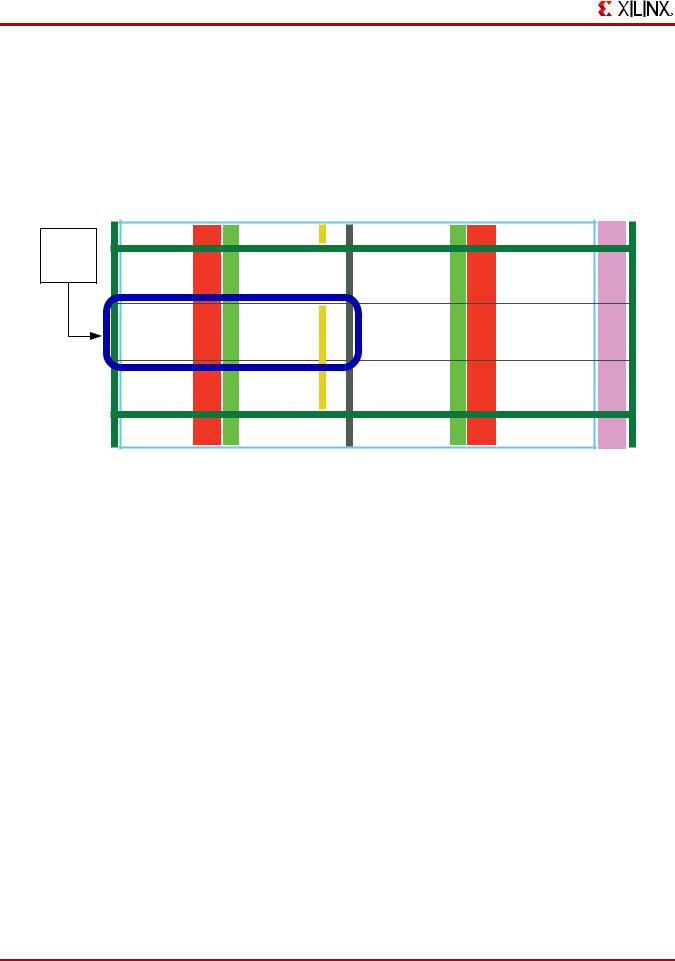
- •Revision History
- •Table of Contents
- •Introduction
- •Design Strategies
- •Large FPGA Devices
- •SSI Technology
- •Large FPGA Device Methodology
- •Benefits
- •Routing Utilization
- •Consequences of Inefficient Use of Routing Resources
- •Improving Routing Utilization
- •Design Performance
- •Power Consumption
- •Project Costs
- •Stacked Silicon Interconnect (SSI)
- •SSI Components
- •Super Logic Region (SLR)
- •Silicon Interposer
- •Super Long Line (SLL) Routes
- •Master Super Logic Region (SLR)
- •Clocking
- •Regional Clocking
- •Global Clocking (BUFG)
- •Management of Design Placement in SLR Components
- •Automatic SLR Assignment
- •Manual SLR Assignment
- •SSI Hierarchy
- •Achieving High Performance Design in SSI Devices
- •SSI Configuration
- •Configuration Details
- •Partial Reconfiguration
- •System Level Design
- •Pinout Selection
- •Consequences of Pinout Selection
- •Using Xilinx Tools in Pinout Selection
- •General Pinout Selection Recommendations
- •Specific Pinout Selection Recommendations
- •Device Migration
- •Control Sets
- •About Control Sets
- •Resets
- •HDL Coding Styles
- •Inference to Device Resources
- •Choosing Good Design Hierarchy
- •Hierarchical Design
- •Functional and Timing Debugging
- •Pipelining
- •Managing Fanout Non-Clock Nets
- •Clocking
- •Selecting Clocking Resources
- •Global Clocking
- •BUFGCE
- •BUFGMUX
- •BUFGCTRL
- •IP and Synthesis
- •Regional Clocking
- •Horizontal Clock Region Buffers (BUFH, BUFHCE)
- •Regional Clock Buffers (BUFR)
- •I/O Clock Buffers (BUFIO)
- •Multi-Regional Clock Buffers (BUFMR)
- •Clocking for SSI Devices
- •Designs Requiring 16 or Fewer Global Clocks
- •Designs Requiring More Than 16 But Fewer Than 32 Global Clocks
- •Designs Requiring More Than 32 Global Clocks
- •Clock Skew in SSI Devices
- •Multiple Die
- •Specifying the Clocking in the Design
- •Controlling Clock Phase, Frequency, Duty Cycle, and Jitter
- •Using Clock Modifying Blocks
- •Using IDELAY to Control Phase
- •Using Gated Clocks
- •Reducing Dynamic Power
- •Output Clocks
- •Clock Domain Crossings
- •Synchronous Domain Crossings
- •Asynchronous Domain Crossings
- •Controlling and Synchronizing Device Startup
- •Using Clock Buffers for Non-Clock Nets
- •Design Performance
- •Using More Than Two BUFG Components or BUFH Components for Non-Clock Signals
- •Using BUFG Components for Mixed Polarity Signals
- •Using Enables Effectively
- •Buffer Selection
- •Specifying Buffer Placement
- •Clock Resource Selection Summary
- •BUFG
- •BUFGCE
- •BUFGMUX and BUFGCTRL
- •BUFH
- •BUFG
- •BUFHCE
- •BUFR
- •BUFIO
- •BUFMR
- •BUFMRCE
- •MMCM
- •IDELAY and IODELAY
- •ODDR
- •Additional Resources
- •Xilinx Resources
- •Hardware Documentation
- •ISE Documentation
- •Partial Reconfiguration Documentation
- •PlanAhead Documentation

Chapter 3: Stacked Silicon Interconnect (SSI)
Clocking
This section discusses clocking, and includes:
•Regional Clocking
•Global Clocking (BUFG)
Regional Clocking
#LOCK
2EGION
8
Figure 3-8: SLR Showing Clock Regions (Enlarged)
The clocking architecture for SSI devices is similar to other Xilinx 7 series FPGA devices.
The regional clocking from the following components have the same connectivity and behavior as in Xilinx 7 series FPGA devices:
•BUFIO
•BUFR
•BUFH
Exception
There is a single exception.
For a BUFMR or BUFMRCE, the buffer does not span across SLR components.
If a BUFMR or BUFMRCE is located in the clock region of an SLR that directly borders a different SLR, then the following limitations apply:
1.The BUFMR or BUFMRCE can access only:
a.The clock region in which it is placed
b.The clock region directly adjacent in the same SLR
2.The BUFMR or BUFMRCE cannot access the adjacent SLR.
Xilinx recommends that you place a BUFMR or BUFMRCE in the center clock region of a given SLR. This gives it full access to span the clock regions above and below.
20 |
www.xilinx.com |
UG872 (v14.3) October 16, 2012 |

Clocking
It might not be necessary now to encapsulate all three clock regions for that particular clock domain. But doing so now gives you greater flexibility in providing the clock to all regions later on. Be sure to take this fact into account during clock and pin planning.
Global Clocking (BUFG)
Global clocking (BUFG) for SSI devices is also similar to other Xilinx 7 series FPGA devices.
•The global clocking topology is identical in the SLR.
•There are 32 available BUFG components that can span the entire device.
•Each BUFG component is capable of driving one of 12 horizontal clocks (BUFH) in a given clock region in the SLR.
For all SLR components in an SSI device (including clocking), make the same assumptions as for any other Xilinx 7 series FPGA device.
The BUFG components in an SLR can also clock synchronous elements in other SLR components. This is demonstrated by the connections and topology of the inter-SLR clocking. Each of the 32 BUFG components in an SLR drives one of 32 vertical tracks called the vertical global clocking line (also known as the global clocking backbone).
This connection traverses to the top and the bottom of the SLR for each BUFG, and allows connectivity to the horizontal row clocking.
At the boundary of the SLR, these vertical clocking spines connect to a very short interposer hop to connect the spine to the corresponding spine of the neighboring SLR.
This process drives the horizontal clocking resources of that SLR, and can continue up or down until all SLR components are connected. It creates a truly global clocking resource.
Because the vertical global clocking lines are a shared resource between the BUFG components of each SLR, some management of these resources might be required.
Large FPGA Methodology Guide |
www.xilinx.com |
21 |
UG872 (v14.3) October 16, 2012
